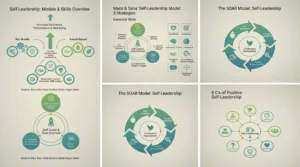
The Big 5 Personality Traits: A Comprehensive Guide to Understanding Human Behavior
- Our Subject Matter Experts
- May 23, 2025
- 6:15 pm
- No Comments

Human Personality is a vast concept that makes every personality unique because each individual holds a personality different from others and behaves differently in various aspects of life scenarios. Our personalities define who we are, which explains why some individuals do well in social situations while others would rather be alone. The Big Five Personality model is evaluated by breaking them into five key dimensions: Openness to experience, conscientiousness, extraversion, agreeableness, and emotional stability. This blog explained the Big Five personality traits in detail, as well as their potential pros and cons.
Big Five Personality Trait- Origin
The Big Five Personality trait is also termed the Five-Factor Model or OCEAN Model. The Big Five Model’s origins span back to the 1960s. Psychologists tried to pinpoint the essential elements of personality. The groundwork was established by the early work of Raymond Cattell and Gordon Allport. Their goal was to classify fundamental personality characteristics. Paul Costa and Robert McCrae built on this study in the 1980s. The five different aspects were identified as a result of their research. The Big Five’s renown in personality psychology was strengthened by their efforts. The validity and reliability of the test are guaranteed by its evidence-based basis. It is widely adaptable due to its cross-cultural applicability.
What are the Big Five Personality Traits?
1. Openness:
It is a personality trait that includes imagination and insight. This personality trait is very high for the world and other people, and a desire to learn and try new things. When it comes to making decisions, it results in a wider variety of interests and more adventure.
The openness attribute is also heavily influenced by creativity, which results in a better comfort level with lateral and abstract thought. Imagine someone with a high openness attribute who constantly orders the most unusual item on the menu, travels to new locations, and has hobbies you never would have considered. A person who scores low on this trait is likely to be seen as having a more conventional outlook on life and may find it difficult to solve problems outside of their area of expertise.
2. Conscientiousness:
High degrees of thoughtfulness, effective impulse control, and goal-directed activities are all characteristics of conscientiousness. Those who work in research and even high-end finance, where attention to every detail and businesses are necessary as skill sets, often exhibit this methodical and disciplined attitude.
A highly thoughtful individual will frequently make plans and consider the impact of their actions on others. To help out in balancing the structural roles within the overall team growth, highly conscientious individuals often work in HR departments and project management teams.
Someone you know who consistently plans ahead for your next meeting and, in the meantime, keeps in touch and inquires about your well-being is a fantastic example of a conscientious individual. When you meet, they are focused on you and like to plan around specific dates and occasions. Individuals with poor conscientiousness sometimes dislike routines and rigidity, put off crucial duties, and neglect to do them altogether.
3. Extraversion:
Many people are familiar with extraversion words, often known as extrovert, at some point in their lives. As “someone who gets energized in the company of others,” it is immediately recognized and distinguished. Many years of social contact have made extraverted individuals easily identifiable due to this and other characteristics, including talking ability, aggressiveness, and high levels of emotional expressiveness. Everybody has at least one family member or friend who isn’t exactly the most outgoing person in a social setting. They love being the center of attention, making new friends, and somehow having the largest circle of connections and peers you have ever come across.
Naturally, the opposite is an introvert we may know in our lives. They lack energy in social settings and prefer to be alone. Making brief conversations or being the focus of attention may be really exhausting.
Extroverts often work in professions that need a lot of public interaction, such as politics, education, marketing, and sales. People who are outgoing are more likely to be perceived as leaders than as passive members of the crowd.
4. Agreeableness:
People who exhibit high agreeableness will display traits of compassion, friendliness, generosity, and trust. Prosocial behaviors are more common among highly pleasant persons, which means that they are individuals who always like to help others. High levels of agreeableness are favored by qualities like sharing, consoling, and collaborating. Empathy towards others is commonly understood as another form of agreeableness, even if the term doesn’t quite fit.
Disagreeableness is the opposite of agreeableness and comes up as socially undesirable behavioral qualities. Cruelty and manipulation of others, a lack of empathy, and a lack of interest in other people and their issues are all more frequent.
Agreeable people alway try to search for jobs in such field where they can help the most. The agreeableness scale gives high marks to individuals in the medical field, mental health, charity work, and even the third sector (social studies).
5. Neuroticism:
Emotional instability, moodiness, and sorrow are traits of neuroticism. Within a person’s daily life neuroticism is a physical and emotional reaction to stress and perceived threats. It is sometimes confused with antisocial conduct or a more serious mental problem.
Anxiety, irritability, and mood swings are common in those with high levels of neuroticism. Some individuals may be very neurotic and respond to high levels of stress in both their personal and professional lives if they experience sudden personality shifts on a regular basis. Anxiety, which contributes significantly to neuroticism, is about a person’s capacity to manage stress as well as imagined or actual risks. Neurotic people tend to overanalyze things and struggle to unwind, even in their own personal space.
Naturally, those with lower neurotic scores will react to stress and circumstances with more stability and mental resilience. Additionally, those with low neuroticism rarely experience sadness or depression, preferring to concentrate on the present moment rather than engage in thought processes on possible stress-inducing factors.
How do the Big Five personality traits influence workplace behaviour?
Whether used for the hiring process or for assessing existing employees, the Big Five Personality Traits test assists in understanding an individual’s behaviour within the workplace and provides indications for analyzing their future performances. Every personality type will have a distinct effect on the workplace, but knowing where these effects might be beneficial and where they could be detrimental can help with recruiting decisions and employee retention.
For example, a candidate with a high openness score is eager to acquire new skills and is likely to come up with abstract solutions when faced with complex issues. Candidates with high conscientiousness scores are motivated to complete their tasks and meet deadlines, and they often need little guidance. The optimum extraversion ratings vary by work function. Candidates with strong extraversion scores perform best in socially interactive settings. The best candidates for jobs requiring personal skills are those with high agreeableness scores. Candidates with high neuroticism scores should do better in jobs requiring a lot of stress or frequent changes.
Read More – Enhancing Workplace Culture Through Personality Assessments
Pros and cons of the Big Five
As we know, every person has some good qualities and some negative ones as well. No one in this entire world is perfect. Human beings always try to showcase their best version in front of their friends or other social groups. On that note, the Big Five Personality Model has some pros and cons.
Pros of the Big Five Model include:
1. Comprehensive Approach
The Big Five Personality Test looks at five key traits: Openness, Conscientiousness, Extraversion, Agreeableness, and Neuroticism. It generally assists in giving a clear view of an individual’s personality. This comprehensive approach helps in enhancing self-awareness and personal development of an individual.
2. Predictive Validity
As per research, numerous life events may be predicted by these personality characteristics, such as academic achievement and improved work performance are often the results of high conscientiousness. On the other hand, health issues may be related to excessive neuroticism.
3. Cross-Cultural Applicability
The Big Five model of personality works well in different dialectics. This applicability makes Big Five Model of Personality a helpful tool for understanding different personalities all around the globe.
4. Facilitates Personal Development
The Big Five test shows personality traits. People have a greater understanding of themselves as a result. They may create goals for themselves and identify areas for improvement. Both professional and personal growth may benefit greatly from this awareness.
5. Assists in Team Building
Team dynamics may be enhanced by being aware of each member’s personality traits. Assigning duties that fit each team member’s skills is made easier by understanding their personalities. This results in better teamwork.
6. Widely accepted and studied
The Big Five concept is well-known and extensively studied in many languages and cultures. This indicates that a lot of studies have been done on the ways in which certain personality qualities might affect relationships, employment, and health, among other areas of life.
Discover What Drives You—Explore the Big 5 Personality Traits Today
Unlock the Secrets of Personality with the Big 5 Traits!
Cons of the Big Five Model include:
1. Potential Oversimplification:
The Big Five approach uses five key characteristics to examine personality. However, it could fail to fully convey the intricacy of the psychology of humans. Certain distinctive traits or actions may not fall within these parameters. If we ignore them, we risk missing important parts of a person’s personality.
2. Prejudice based on culture:
The WEIRD societies are the primary source of the Big Five framework. They are Western, educated, industrialized, rich, and democratic. It is thus unknown how it is used in various cultures. It could miss details of individual traits.
3. Self-Reporting Bias:
The Big Five personality test depends on self-assessment. This can be affected by how people see themselves and how honest they are. Misunderstanding questions, low self-awareness, and a wish to please others can cause inaccuracies. These issues can make the test less reliable.
4. Dynamic Nature of Personality:
Personality is dynamic. It can evolve due to various life events, personal growth, and circumstances. The Big Five model shows personality at one moment. It might not reflect how individual personality changes over time.
5. Time-Consuming Assessments:
It takes time to complete Big Five assessments. They need plenty of hard work to complete and evaluate. When time is limited, shorter tests can be better, even if they lack depth.
6. Limited practical applications:
In some situations, like clinical psychology or counseling, where more specialized models could be more applicable, the Big Five model of personality may have limited practical applicability despite its potential to be useful in understanding individual differences and team dynamics.
Are Big Five personality assessments trustworthy?
Since its development in the early 1990s, the Big Five personality model has gained widespread popularity for its proven evidence basis. It is the most powerful tool used for understanding how people think, feel, and behave. While personality can evolve over time, these changes tend to be subtle and gradual rather than dramatic shifts. On the other hand, it is very important to recognize the limits of personality tests. They aren’t designed to diagnose mental health conditions. Instead, tools like the Big Five offer valuable insights into our behavioral patterns, helping us make more informed personal and professional decisions.
Big Five tests- Importance in the hiring process.
In addition to understanding how your candidates’ personalities align with certain projects and tasks, there are two reasons why the Big Five Model is important for hiring:
1. Find out how the personalities of potential candidates match the goals of your business: The Big Five Personality traits score evalution enables you to determine if the behavior of your candidates corresponds with the culture of your business. Candidates with high openness scores, for instance, maybe a good match if your company prioritizes creativity and innovation since they are generally more receptive to new ideas and experiences.
You can create and maintain a diverse workplace culture by being aware of these characteristics. More significantly, it reveals if a candidate would thrive in the position and fit well with your current team dynamics.
According to recent research, particular traits help individuals perform better in certain positions. For example, supervisors often have high conscientiousness scores, which are linked to being well-organized and trustworthy.
2. Make use of the findings for future training opportunities: Recruiters may quickly utilize the Big 5 Personality Assessment test findings as a foundation for creating training and development opportunities that will increase workplace efficiency.
For example, your candidate may have a high neuroticism score. People with neurotic personality types are more likely to suffer from anxiety, stress, and other mental health conditions, which may sometimes restrict their capacity to function well under pressure. Your training sessions could focus on developing the particular abilities that the candidate lacks, such as enhancing their emotional stability, fostering resilience, and preserving teamwork and unity.
How to use your Big Five personality results to live a better life
It’s time to apply your Big Five traits after receiving your test results. You may utilize your findings to improve your life experiences in the following ways:
1. Increase your career satisfaction
You might choose job that organically motivates you based on your personality attributes. For example, if you’re a diligent person, you’ll probably do well in positions that need careful preparation and attention to detail, such as operations or project management. If you have less of this quality, look for jobs that provide you more freedom while using outside resources and accountability partners to help you remain on track.
2. Strengthen your relationships
Being aware of your Five Factor Model profile might change the way you interact with other people. Consider extraversion as an example. If you have a high score, you may use your social energy to organize frequent events or create stronger bonds by doing group fitness training. If your score is lower, you may concentrate on having meaningful one-on-one conversations, honing your social skills in relaxed settings, and building recovery time into your schedule after social gatherings.
3. Improve your stress management
Using your neuroticism score, you may create customized techniques for reducing stress. Establishing an everyday routine that incorporates meditation, regular exercise, and allocated “worry time” to address worries may be beneficial for someone with high neuroticism. You may get more emotional stability by identifying your tendencies and adopting healthy behaviors.
4. Develop better conflict resolution skills
How you resolve conflicts might be influenced by your agreeableness score. As an example, if your agreeableness score is low, you may work on actively asking others to clarify their opinions and taking a moment before answering them. This little change may help transform possible conflicts into chances for better understanding.
Here, too, your openness score is important. People that are open-minded often approach disagreement with curiosity and an openness to considering other viewpoints. By practicing active listening and experimenting with different conflict resolution techniques, you may improve your conflict resolution skills if your openness score is lower.
Applications of the Big Five Modle
The Big Five Personality test is best thought of as a series of interconnected scales. Although each person will fall somewhere on the scale, assessments that use the OCEAN framework aim to figure out the level to which a individual shows traits addressed by every domain.
In addition to building teams with balanced or equivalent personality traits, several organizations utilize employee ratings to assess cultural fit. Some even go so far as to provide staff with an overview of their findings and suggestions on how to interact with employees of various personality types.
The most common uses of the Five Big Personality Test, is outside of HR departments are marketers. The model is used to assist understand audiences and what might appeal to them based on the similarities in their personality traits. It is often used when combined with demographic or other targeting considerations.
Can your Big Five personality traits change over time?
As per the years of study on The Big Five model reveals that personality characteristics are both fixed and adaptable. Relationships, shifts at work, life events, and personal development may all affect how these traits manifest over time.
Most people tend to grow in socially desirable ways as they age. According to this trend, which is sometimes referred to as the maturity principle, traits like conscientiousness, emotional stability, and agreeableness tend to rise from early adulthood through midlife. To put it another way, individuals gradually tend to become more cooperative, emotionally stable, and responsible.
This implies that your personality is not defined. Even if some traits can seem unchangeable, you can grow and evolve, particularly if you’re conscious of your behaviors and open to new experiences. You may improve the aspects of your personality that help you achieve your objectives and maintain your wellbeing with time and deliberate work.
Read More – How Work Personality Assessments Can Drive Team Productivity
Conclusion
The Big Five Personality assessment, also known as the OCEAN model, offers a well-rounded and research-backed approach to understanding human behavior. By breaking down personality into five measurable traits—Openness, Conscientiousness, Extraversion, Agreeableness, and Neuroticism. It gives individuals and organizations a powerful tool for self-awareness, team-building, and talent management.
Tools like the Big Five model provide practical insights in a society that places a greater emphasis on emotional intelligence, teamwork, and flexibility. These characteristics operate as a reflection for people, enabling them to examine how they behave, think, and interact in many situations in both their personal and professional lives. Organizations may find the ideal cultural fit, lower attrition, and boost productivity by knowing these personality traits, particularly when it comes to hiring and team building.
However, like any psychological framework, the Big Five model isn’t without limitations. Although it has shown cross-cultural applicability and is based on years of investigation, it may not be able to predict behavior in very specific settings or capture every aspect of human nature. Additionally, it makes extensive use of self-reporting, which may induce bias. Nevertheless, it continues to be one of the most accurate and useful personality tests accessible when used carefully and in conjunction with other assessment tools.
In the end, the Big Five model is more than just a way to categorize people. Whether you’re a professional making career choices, a manager creating a high-performing team, or a student trying to identify your skills, it promotes personal development, empathy, and improved interpersonal dynamics. This kind of awareness is not only beneficial but also necessary in the varied and dynamic situations of today.
FAQ
A psychological technique for evaluating a person’s personality along five major aspects is the Big Five Personality evaluation. These traits—Openness, Conscientiousness, Extraversion, Agreeableness, and Neuroticism offer a thorough grasp of how people generally feel, think, and act. Self-development, education, psychology, and recruiting all make significant use of the test.
The Big Five model consists of:
- Openness to Experience: Imagination, curiosity, and creativity.
- Conscientiousness: Organization, responsibility, and goal orientation.
- Extraversion: Outgoingness, energy, and sociability.
- Agreeableness: Kindness, cooperation, and empathy.
- Neuroticism: Emotional instability, anxiety, and moodiness.
The Big Five model evolved over decades through research by psychologists like Lewis Goldberg, Robert McCrae, and Paul Costa. It is based on factor analysis—a statistical method that identifies groups of related traits from thousands of descriptive terms used to characterize personality.
Yes, the Big Five model is backed by decades of research and is considered one of the most scientifically robust personality frameworks. It has been tested across cultures, age groups, and contexts and continues to be widely used in psychological research and professional applications.
The MBTI (Myers-Briggs Type Indicator) categorizes people into 16 personality types based on preferences. In contrast, the Big Five measures traits on a continuous scale, offering a more nuanced view. Also, the Big Five has stronger empirical support in psychological science.
Yes, although personality traits are relatively stable, they can evolve. Major life events, personal growth, aging, and consistent efforts toward self-improvement can shift your levels of conscientiousness, emotional stability, and more.
The accuracy largely depends on the honesty of the person taking it. If taken sincerely, the test yields a reliable representation of one’s personality, helping in career choices, self-awareness, and improving interpersonal relationships.
Organizations use the Big Five to understand employee behaviors better, improve hiring processes, build effective teams, and tailor leadership development programs. For instance, high conscientiousness often correlates with job performance, while high agreeableness may benefit teamwork.
Yes, several websites offer free versions of the Big Five test. While these can provide good insights, more comprehensive and validated versions are often available through psychologists or paid services, which may include in-depth reports.
Some therapists use the Big Five to assess their clients’ personalities and design more effective treatment strategies. Understanding a client’s traits can help therapists choose the best communication style, set realistic goals, and predict behavioral patterns.
A high score in Openness indicates that a person is imaginative, open to new experiences, enjoys artistic activities, and often thinks abstractly. Such individuals may thrive in creative fields or roles that involve innovation and exploration.
A low score suggests that the individual may be more spontaneous, less structured, and may struggle with organization or meeting deadlines. While this can pose challenges in certain roles, such individuals may excel in dynamic or unstructured environments.
In the Big Five model, a low Extraversion score reflects introverted tendencies. This doesn’t mean someone is antisocial—it simply means they may prefer solitude, deep conversations over small talk, and need alone time to recharge.
Yes, cultural norms and societal expectations can influence how traits are expressed. For example, assertiveness (linked to Extraversion) may be encouraged in Western cultures but seen as impolite in more collectivist societies.
Not necessarily. While high levels of Neuroticism can indicate susceptibility to stress and mood swings, moderate levels can enhance self-awareness, emotional depth, and sensitivity, which are valuable in many personal and professional contexts.
Yes, but they must ensure the test is job-related and doesn’t discriminate. Employers should use validated assessments, inform candidates about the purpose, and follow ethical guidelines to avoid legal or moral issues.
People who score high in Agreeableness tend to be cooperative, empathetic, and team-oriented. Careers in social work, nursing, customer service, teaching, and counseling often align well with this personality trait.
If your results feel off, consider retaking the test with more thoughtful answers. Also, keep in mind that mood, context, and recent experiences can affect your self-perception during the test.
Absolutely. Students can use the Big Five to understand their learning styles, choose compatible study environments, improve time management, and explore careers that align with their personality traits.
No personality profile is inherently better than another. Each trait has strengths and potential challenges. Success and satisfaction often come from understanding your traits and leveraging them effectively rather than trying to fit a particular mold.






